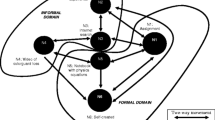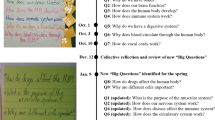Abstract
Recent theoretical advances on learning (mathematics) emphasize the fact that what results from engagement with curriculum materials is not entirely in the control of the students in the way classical theories of knowing and learning suggest. These new theories distinguish themselves by either invoking distributed agency, some of which is attributed to non-human aspects of the environment, or by emphasizing the essential (radical) passivity that characterizes coming to know. In this study, an alternative is offered: making as a modality of growing. This move allows us to capture theoretically that both growers-makers and their materials grow (old) together. The proposed approach troubles existing ones because it shifts our perspective from a transitive relation between students and the curricular objects to an intransitive one, where the becoming of each is described in terms of Deleuzian lines of flight. A case study involving two girls and tangram pieces is described in terms of growing together and becoming-hexagon. Implications are discussed for how researchers can capture the non-agential, non-causal dimensions of coming to know.







Similar content being viewed by others
Notes
Grammatically, a transitive verb expresses an action that passes from the subject S to the object O (e.g., “The student constructs a hexagon”); an intransitive verb expresses an action does not have a direct object (e.g., “the tree grows).
In classical, Newtonian mechanics, the movement of an object is described by the equation F = m · a, that is, a force that causes acceleration in the direction of the force. In Lagrangian mechanics, the forces F i are orthogonal to the displacement of the object δ r i. A description of the motion can be derived based on the fact that the inner product F i · δ r i = 0.
Perpendicularity (orthogonality) is used in the sense of vector algebra, where there is no overlap when two vectors include a 90° angle, that is, when the inner (dot) product equals 0.
References
Châtelet, G. (1993). Les enjeux du mobile: Mathématique, physique, philosophie [The stakes of movement: Mathematics, physics, philosophy]. Paris: Éditions du Seuil.
de Freitas, E. (2012). The classroom as rhizome: New strategies for diagramming knotted interactions. Qualitative Inquiry, 18, 557–570.
de Freitas, E., & Sinclair, N. (2012). Diagram, gesture, agency: Theorizing embodiment in the mathematics classroom. Educational Studies in Mathematics, 80, 133–152.
de Freitas, E., & Sinclair, N. (2013). New materialist ontologies in mathematics education: The body in/of mathematics. Educational Studies in Mathematics, 83, 453–470.
de Freitas, E., & Sinclair, N. (2014). Mathematics and the body: Material entanglements in the classroom. Cambridge: Cambridge University Press.
Deleuze, G., & Guattari, F. (1980). Mille plateaux: Capitalisme et schizophrénie [A thousand plateaus: Capital and schizophrenia]. Paris: Les Éditions de Minuit.
Garfinkel, H. (2002). Ethnomethodology’s program: Working out Durkheim’s aphorism. Lanham: Rowman & Littlefield.
Husserl, E. (1976). Husserliana Band VI. Die Krisis der europäischen Wissenschaften und die transzendentale Phänomenologie. Eine Einleitung in die phänomenologische Philosophie [Husserliana vol. 6: The crisis of the European sciences and transcendental phenomenology. An introduction to phenomenological philosophy]. The Hague, The Netherlands: Martinus Nijhoff.
Ingold, T. (2000). The perception of the environment: Essays on livelihood, dwelling and skill. London: Routledge.
Ingold, T. (2011). Being-alive: Essays on movement, knowledge and description. London: Routledge.
Ingold, T. (2013). Making: Anthropology, archeology, art and architecture. London: Routledge.
Ingold, T. (2015). The life of lines. London: Routledge.
Johnson, M. (1987). The body in the mind: The bodily basis of imagination, reason, and meaning. Chicago: Chicago University Press.
Kieren, T., & Simmt, E. (2009). Response to Fazio and Gallagher: Brought forth in bringing forth. The inter-actions and products of a collective learning system. Complicity: An International Journal of Complexity and Education, 6(2), 20–28.
Lave, J. (1993). The practice of learning. In S. Chaiklin & J. Lave (Eds.), Understanding practice: Perspectives on activity and context (pp. 3–32). Cambridge: Cambridge University Press.
Livingston, E. (2008). Ethnographies of reason. London: Routledge.
Marx, K., & Engels, F. (1978). Werke Band 3 [Works vol. 3]. Berlin: Dietz.
Marx, K., & Engels, F. (1983). Werke Band 42 [Works vol. 42]. Berlin: Dietz.
McDermott, R. P., Gospodinoff, K., & Aron, J. (1978). Criteria for an ethnographically adequate description of concerted activities and their contexts. Semiotica, 24, 245–275.
Mol, A., & Law, J. (1994). Regions, networks and fluids: Anemia and social topology. Social Studies of Science, 24, 641–671.
Rasmussen, C., Wawro, M., & Zandieh, M. (2015). Examining individual and collective mathematical progress. Educational Studies in Mathematics, 88, 259–281.
Reid, D. A. (2014). The coherence of enactivism and mathematics education research: A case study. Avant, 5(2), 137–172.
Proulx, J. (2013). Mental mathematics, emergence of strategies, and the enactivist theory of cognition. Educational Studies in Mathematics, 84, 309–328.
Roth, W.-M., & Maheux, J.-F. (2015a). The stakes of movement: A dynamic approach to mathematical thinking. Curriculum Inquiry, 45, 266–284.
Roth, W.-M., & Maheux, J.-F. (2015b). The visible and the invisible: The immanence of doing mathematics and mathematics as revelation. Educational Studies in Mathematics, 88, 221–238.
Schoenfeld, A. H. (1998). Making mathematics and making pasta: From cookbook procedures to really cooking. In J. G. Greeno & S. V. Goldman (Eds.), Thinking practices in mathematics and science learning (pp. 299–319). Mahwah: Lawrence Erlbaum Associates.
Sheets-Johnstone, M. (2009). The corporeal turn: An interdisciplinary reader. Exeter: Imprint Academic.
Sheets-Johnstone, M. (2011). The primacy of movement: Expanded second edition. Amsterdam: John Benjamins.
Sinclair, N., de Freitas, E., & Ferrara, F. (2013). Virtual encounters: The murky and furtive world of mathematical inventiveness. ZDM Mathematics Education, 45, 239–252.
Thompson, P. W. (2015). Researching mathematical meanings for teaching. In L. D. English & D. Kirshner (Eds.), Third handbook of international research in mathematics education (pp. 968–1002). New York: Taylor & Francis.
Turnbull, D. (1993). The ad hoc collective work of building gothic cathedrals with templates, string, and geometry. Science, Technology & Human Values, 18, 315–340.
von Glasersfeld, E. (1989). Cognition, construction of knowledge, and teaching. Synthese, 80, 121–140.
Vygotsky, L. S. (1997). The collected works of L. S. Vygotsky, vol. 4: The history of the development of higher mental functions. New York: Springer.
Acknowledgments
Data collection for this study was supported by a research grant from the Social Sciences and Humanities Research Council of Canada. I thank Alfredo Bautista, Maria Inês Mafra Goulart, Jean-François Maheux, and Jennifer Thom for their contributions to the implementation of the curriculum and the data collection.
Author information
Authors and Affiliations
Corresponding author
Rights and permissions
About this article
Cite this article
Roth, WM. Growing-making mathematics: a dynamic perspective on people, materials, and movement in classrooms. Educ Stud Math 93, 87–103 (2016). https://doi.org/10.1007/s10649-016-9695-6
Published:
Issue Date:
DOI: https://doi.org/10.1007/s10649-016-9695-6




